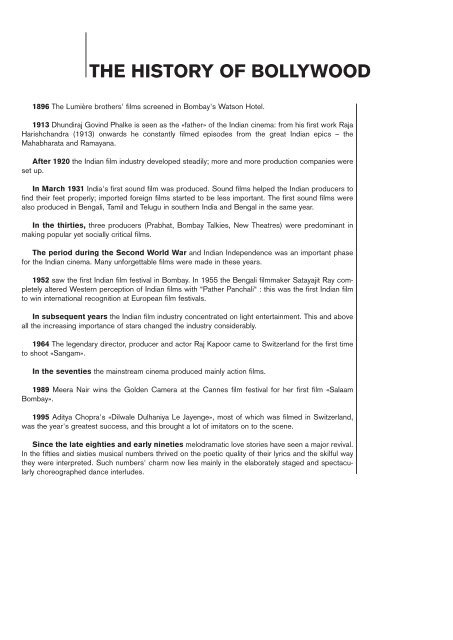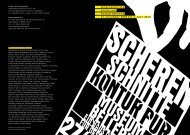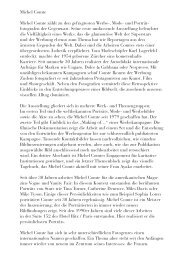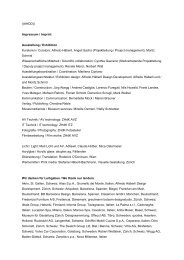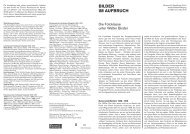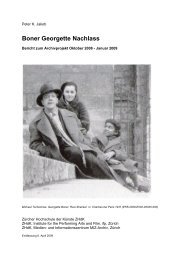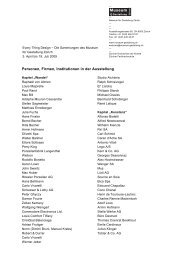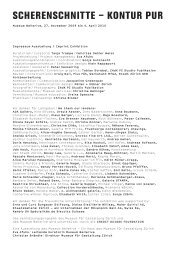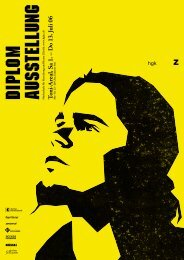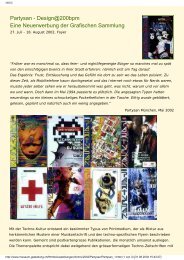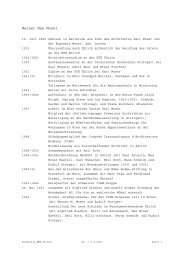THE HISTORY OF BOLLYWOOD
THE HISTORY OF BOLLYWOOD
THE HISTORY OF BOLLYWOOD
You also want an ePaper? Increase the reach of your titles
YUMPU automatically turns print PDFs into web optimized ePapers that Google loves.
<strong>THE</strong> <strong>HISTORY</strong> <strong>OF</strong> <strong>BOLLYWOOD</strong><br />
1896 The Lumière brothers' films screened in Bombay's Watson Hotel.<br />
1913 Dhundiraj Govind Phalke is seen as the «father» of the Indian cinema: from his first work Raja<br />
Harishchandra (1913) onwards he constantly filmed episodes from the great Indian epics – the<br />
Mahabharata and Ramayana.<br />
After 1920 the Indian film industry developed steadily; more and more production companies were<br />
set up.<br />
In March 1931 India's first sound film was produced. Sound films helped the Indian producers to<br />
find their feet properly; imported foreign films started to be less important. The first sound films were<br />
also produced in Bengali, Tamil and Telugu in southern India and Bengal in the same year.<br />
In the thirties, three producers (Prabhat, Bombay Talkies, New Theatres) were predominant in<br />
making popular yet socially critical films.<br />
The period during the Second World War and Indian Independence was an important phase<br />
for the Indian cinema. Many unforgettable films were made in these years.<br />
1952 saw the first Indian film festival in Bombay. In 1955 the Bengali filmmaker Satayajit Ray completely<br />
altered Western perception of Indian films with “Pather Panchali“ : this was the first Indian film<br />
to win international recognition at European film festivals.<br />
In subsequent years the Indian film industry concentrated on light entertainment. This and above<br />
all the increasing importance of stars changed the industry considerably.<br />
1964 The legendary director, producer and actor Raj Kapoor came to Switzerland for the first time<br />
to shoot «Sangam».<br />
In the seventies the mainstream cinema produced mainly action films.<br />
1989 Meera Nair wins the Golden Camera at the Cannes film festival for her first film «Salaam<br />
Bombay».<br />
1995 Aditya Chopra's «Dilwale Dulhaniya Le Jayenge», most of which was filmed in Switzerland,<br />
was the year's greatest success, and this brought a lot of imitators on to the scene.<br />
Since the late eighties and early nineties melodramatic love stories have seen a major revival.<br />
In the fifties and sixties musical numbers thrived on the poetic quality of their lyrics and the skilful way<br />
they were interpreted. Such numbers' charm now lies mainly in the elaborately staged and spectacularly<br />
choreographed dance interludes.
25 May to 8 September 2002<br />
Museum für Gestaltung Zurich<br />
<strong>BOLLYWOOD</strong><br />
<strong>THE</strong> INDIAN CINEMA AND SWITZERLAND<br />
Nowadays Switzerland is to Bollywood what the Far East once was to Hollywood: an enticing paradise,<br />
heaven on earth. Bollywood, the greatest dream factory on the Indian subcontinent, is the most<br />
productive film industry in the world. The studios in and around Bombay bring over 800 productions per<br />
year to the screen. In comparison, Hollywood manages only 600. Romantic comedies make the best<br />
box-office draws as Bollywood films, formulaic stories with the right mixture of emotional ingredients like<br />
happiness and despair, love, rage and grief, surprise and heroism. Romantic song and dance numbers<br />
are staple Bollywood features. The films last three hours on average and include at least six songs in<br />
which the singing and dancing hero and heroine swear eternal love for each other, whether this fits in<br />
with the plot of the film or not. Some of the song and dance numbers are shot in Switzerland. Lush<br />
Alpine meadows, white peaks, shiny railways and picturesque chalets make the ideal setting for<br />
Bollywood stars singing their tuneful declarations of love. The song routines used to be shot in Kashmir,<br />
Indian mythology's standard land of longing. But political unrest and border disputes with Pakistan have<br />
pretty well ruled out the Kashmir valley as a location. Switzerland, with its impeccable infrastructure and<br />
its mountains - just as beautiful as Kashmir's –, has become the most popular substitute. And now more<br />
feet of film are shot per year in Switzerland by Indian film crews than by native ones. So Switzerland<br />
has long been a fantasy focus in the everyday life of Indian film fans (and given the audience figures you<br />
could simplify that by saying in everyday Indian life): as a mixture of the national clichés that are known<br />
all over the world and the images of longing that Bollywood films project on to the Swiss Alpine meadows.<br />
Recently people who are in a position to do so have started to check out this paradise for themselves.<br />
More and more middle-class Indians are travelling to Switzerland. Comparing film fantasies with<br />
reality tends to be to the disadvantage of the latter, but our Indian cinema tourists are still reluctant to<br />
miss an opportunity to sing their beloved idols' songs on the summits of Rigi and Titlis.<br />
Bollywood. The Indian Cinema and Switzerland is a Museum für Gestaltung exhibition based on a<br />
joint research project with the Film Science seminar at the University of Zurich. It uses clips from films,<br />
stills, photographs, posters, models and clay statues to illustrate how the emotional landscape called<br />
«Switzerland» has been constructed in the Indian cinema – a landscape that we think we know so well,<br />
and that we can in fact rediscover from scratch in this exhibition.
PUBLICATION<br />
<strong>BOLLYWOOD</strong> – <strong>THE</strong> INDIAN CINEMA AND SWITZERLAND<br />
EDITION MUSEUM FÜR GESTALTUNG ZURICH<br />
An illustrated reader<br />
30 x 23 cm, 192 pages, 250 colour illustrations<br />
ISBN 3-907065-95-6, approx. CHF 48 / Euro 25<br />
The authors are from the film world and India. They work as film academics,<br />
film critics, filmmakers, ethnologists, with one geographer, one India scholar, one<br />
photographer and one writer; they live in Berlin, Bern, Bombay, Delhi, London,<br />
Auckland, New York and Zurich.<br />
SUMMARY <strong>OF</strong> CONTENTS:<br />
SALAAM. WELCOME. NAMASKAR<br />
Introduction (Alexandra Schneider, Zurich / Cecilia Hausheer, Zurich)<br />
Switzerland: A Disneyland of Love (Meenakshi Shedde, Bombay)<br />
India's popular cinema (Dorothee Wenner, Berlin)<br />
PARADISE. MUSIC. EMOTION<br />
An Encyclopaedia of Love (Riyad Vinci Wadia, Bombay, New York /<br />
Dorothee Wenner, Berlin)<br />
Myth, metaphor, Masala – cultural aspects of the Bollywood film<br />
(Amrit Gangar, Bombay)<br />
Bollywood sings and dances in Switzerland (Till Brockmann, Zurich)<br />
«Cinema is our second religion» (Dayanita Singh, Delhi)<br />
La! La La La Laaa! – no Bollywood film without music<br />
(Riyad Vinci Wadia, Bombay, New York)<br />
The Stars' Darshana (Vikram Chandra, Bombay)<br />
LANDSCAPE. TOURISM. MOBILITY<br />
Landscape of love – the Indian middles classes, romantic love and consumer<br />
thinking (Rachel Dwyer, London)<br />
«You have to have been there» – Indian tourism in Switzerland<br />
(Urs Keller, Zurich)<br />
One train says more than 1000 words (Vinzenz Hediger, Zurich)<br />
Bollywood travels around Switzerland – a catalogue<br />
(Alexandra Rozkosny, Zurich)<br />
The mountains from the Swiss point of view – an expedition through Swiss<br />
feature films (Yvonne Zimmermann, Zurich)<br />
EAST. WEST. MIGRATION<br />
«Home away from home» or why Switzerland does(n't) play a part in Indian cinema<br />
(Alexandra Schneider, Zurich)<br />
India is different (Dorothee Wenner, Berlin)<br />
A media window on home– Tamils in Swiss exile and the Indian film<br />
(Damaris Lüthi, Zurich)<br />
The heart is still Indian: Bollywood and the South Asian diaspora<br />
(Shuchi Kothari / Nabeel Zuberi, Auckland)
FILM SERIES<br />
Bollywood films in the Xenix Cinema, Zurich, 27 May to 11 July.<br />
You can savour the emotions triggered by the exhibition in full-length films – in<br />
an almost entirely authentic experience in the Xenix cinema. The film series, to be<br />
launched on 27 May in the Volkshaus Zurich with a gala screening, will survey of<br />
the history and development of the commercial Hindi cinema in about 15 titles –<br />
from the thirties to the present day. www.xenix.ch<br />
LECTURE SERIES<br />
Talks in the Museum für Gestaltung Zurich<br />
A series of lectures about Bollywood cinema by distinguished film academics,<br />
critics and filmmakers will be held during the exhibition («The eroticism of the wet<br />
sari», «The internationalization of Bollywood» etc.). For exact details see daily<br />
press.<br />
IMPRINT<br />
<strong>BOLLYWOOD</strong> – <strong>THE</strong> INDIAN CINEMA AND SWITZERLAND<br />
A joint venture by the Museum für Gestaltung Zurich and the University of Zurich's film<br />
science seminar. The research was supported by the Gebert Rüf Foundation.<br />
RESEARCH TEAM<br />
Alexandra Schneider, Zurich / Till Brockmann, Zurich / Cecilia Hausheer, Zurich.<br />
Project assistants: Dorothee Wenner, Berlin / Alexandra Roskozny, Zurich / Urs<br />
Keller, Zurich / Riyad Vinci Wadia, Bombay, New York<br />
EXHIBITION<br />
Curators: Cecilia Hausheer, Meret Ernst<br />
Exhibition assistant: Gabriella De Gara<br />
Exhibition design: This Dormann<br />
Exhibition secretary: Tina Schalow<br />
PUBLICATION<br />
Editors: Alexandra Schneider, Christina Reble, Doris Senn<br />
Book design: Trix Wetter<br />
FILM SERIES<br />
Curator: Rosa Maino


